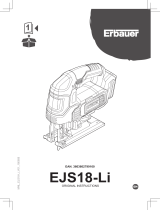
CORDLESS JIGSAW 20V - BODY ONLY
MODEL NO: CP20VJS
Thank you for purchasing a Sealey product. Manufactured to a high standard, this product will, if used according to these
instructions, and properly maintained, give you years of trouble free performance.
IMPORTANT: PLEASE READ THESE INSTRUCTIONS CAREFULLY. NOTE THE SAFE OPERATIONAL REQUIREMENTS, WARNINGS & CAUTIONS. USE
THE PRODUCT CORRECTLY AND WITH CARE FOR THE PURPOSE FOR WHICH IT IS INTENDED. FAILURE TO DO SO MAY CAUSE DAMAGE AND/OR
PERSONAL INJURY AND WILL INVALIDATE THE WARRANTY. KEEP THESE INSTRUCTIONS SAFE FOR FUTURE USE.
1. SAFETY
1.1. BATTERY CHARGER SAFETY INSTRUCTIONS
WARNING! DO NOT use the charging base to charge any battery other than that required for the tool.
Other types of batteries may explode!
9 Inspect the plug, cable and the charging base for wear and damage to ensure items are safe before connecting to the mains power
supply. If worn or damaged DO NOT use, immediately replace, or contact a qualied electrician.
9 Check cables are always protected against short circuit and overload.
9 Uncoil the power cable between the plug and the charging base before use.
8 DO NOT pull or carry the charging base by the charger power lead, or pull the plug from the mains socket by the power lead.
8 DO NOT use any other type of transformer with the charging base.
8 DO NOT try to open or dis-assemble the plug or charging base.
8 DO NOT use the plug to power any other electrical item.
9 Disconnect the charging base from the mains power supply when not in use.
8 DO NOT expose the charging base to damp or wet conditions (for indoor use only).
8 DO NOT operate the charging base if it has been dropped, or has received a sharp knock, or is damaged. Contact an authorised
service agent.
8 DO NOT dismantle the charging base as this may cause damage or personal injury and will invalidate your warranty.
8 DO NOT insert foreign objects or material into the slot reserved for the battery.
8 DO NOT immediately charge a second battery. Consecutive charging will overheat the charging base. Allow the unit to cool for 15
minutes before charging the next battery.
9 Ensure that the insulation on all cables and on the appliance is safe before connecting it to the power supply.
9 Ensure that cables are always protected against short circuit and overload.
8 DO NOT use worn or damaged cables, plugs or connectors. Immediately have any faulty item replaced by a qualified electrician.
1.2. BATTERY SAFETY INSTRUCTIONS.
WARNING! Battery contains Lithium-ion which is dangerous. Handle with care to avoid damage, re, corrosion or personal injury.
9 Charge battery prior to its rst use. The battery will have been shipped in a low charge state. To reduce the risk of burns or fire:
8 DO NOT Attempt to open, disassemble, modify or service the battery pack.
8 DO NOT Crush, puncture, short external contacts or dispose of in fire or water.
8 DO NOT Expose to temperatures above 40°C (104°F).
9 Replace only with the battery pack designated for this product.
9 Use only the charging base provided to charge the grinder battery.
8 DO NOT attempt recharging the battery by means of an engine generator or a DC power source.
WARNING! Dispose of spent batteries correctly as they contain Lithium-ion.
▲ DANGER! DO NOT attempt to disassemble the battery. For safety and environmental reasons DO NOT discard in domestic waste
or by burning. ONLY discard or recycle according to local authority regulations.
WARNING! DO NOT allow a leaking battery to contact your person.
1.3. GENERAL SAFETY.
9 Read all safety warnings and all instructions. Failure to follow the warnings and instructions may result in electric shock, re and/or
serious injury.
9 Save all warnings and instructions for future reference.
9 Keep work area clean and well lit.
9 Keep children and unauthorised persons away from the working area.
9 Avoid body contact with earthed or grounded surfaces, such as pipes, radiators, ranges and refrigerators.
9 There is an increased risk of electric shock if your body is earthed or grounded.
8 DO NOT expose power tools to rain or wet conditions. Water entering a power tool will increase the risk of electric shock.
9 Stay alert, watch what you are doing and use common sense when operating a power tool.
9 Use personal protective equipment. Always wear eye protection. Protective equipment such as dust mask, non-skid safety shoes,
hard hat, or hearing protection used for appropriate conditions will reduce personal injuries.
9 Avoid unintentional starting.
8 DO NOT carry the tool with your nger on the power switch.
8 DO NOT overreach. Keep proper footing and balance at all times.
9 Remove ill tting clothing. Remove ties, watches, rings and other loose jewellery and contain long hair.
CP20VJS Issue 2 13/05/21
Original Language Version
© Jack Sealey Limited
Refer to
instructions
Wear eye
protection
Wear protective
gloves
Wear ear
protection
Wear safety
footwear
Wear protective
clothing
Wear a mask




